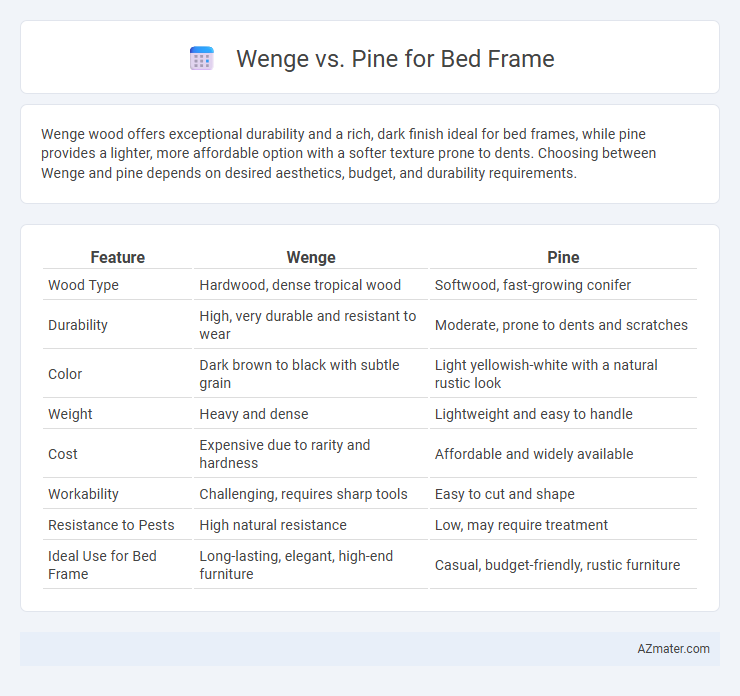Wenge wood offers exceptional durability and a rich, dark finish ideal for bed frames, while pine provides a lighter, more affordable option with a softer texture prone to dents. Choosing between Wenge and pine depends on desired aesthetics, budget, and durability requirements.
Table of Comparison
| Feature | Wenge | Pine |
|---|---|---|
| Wood Type | Hardwood, dense tropical wood | Softwood, fast-growing conifer |
| Durability | High, very durable and resistant to wear | Moderate, prone to dents and scratches |
| Color | Dark brown to black with subtle grain | Light yellowish-white with a natural rustic look |
| Weight | Heavy and dense | Lightweight and easy to handle |
| Cost | Expensive due to rarity and hardness | Affordable and widely available |
| Workability | Challenging, requires sharp tools | Easy to cut and shape |
| Resistance to Pests | High natural resistance | Low, may require treatment |
| Ideal Use for Bed Frame | Long-lasting, elegant, high-end furniture | Casual, budget-friendly, rustic furniture |
Introduction to Wenge and Pine Wood
Wenge wood, sourced primarily from the African Millettia laurentii tree, is recognized for its deep, dark brown coloration with striking black streaks, offering exceptional durability and a dense, heavy grain. Pine wood, derived from various species of the Pinus genus, features a lighter, creamy color with a softer texture and visible knots, known for its affordability and ease of workability. Both woods are popular choices for bed frames, balancing aesthetics and structural strength, but Wenge's density and unique grain make it a premium option compared to the more rustic and versatile Pine.
Visual Appearance: Wenge vs Pine
Wenge bed frames feature a dark, rich brown color with a distinctive grain pattern that adds a sophisticated and modern look to any bedroom. Pine bed frames offer a lighter, creamy yellow tone with visible knots and a rustic, natural charm that suits traditional or country-style decor. The choice between Wenge and Pine for visual appearance depends on whether you prefer a sleek, contemporary aesthetic or a warm, cozy ambiance.
Durability and Strength Comparison
Wenge offers superior durability and strength due to its dense, hardwood composition, making it highly resistant to dents and wear. Pine, a softer and lighter wood, is more prone to scratches and dents but provides flexibility and ease of customization. For long-lasting, robust bed frames, Wenge outperforms Pine, especially in resisting structural damage over time.
Cost and Affordability
Wenge wood offers a luxurious appearance with its deep, rich color but comes at a significantly higher price point due to its rarity and durability. Pine wood is a budget-friendly option, providing affordability and ease of sourcing while being softer and more prone to dents or scratches. Choosing pine can reduce the initial investment for a bed frame, whereas wenge is better suited for long-term value and high-end aesthetics.
Workability and Ease of Crafting
Wenge wood offers high durability and a dense grain, making it more challenging to work with hand tools but ideal for achieving a sleek, modern bed frame finish. Pine is softer and lighter, providing excellent workability and ease of crafting for DIY projects or intricate designs. Pine's forgiving nature reduces tool wear and allows for faster assembly, while Wenge requires precision and experience to avoid chipping or splintering during construction.
Maintenance and Longevity
Wenge wood offers exceptional durability and requires minimal maintenance due to its dense, oily nature that resists moisture and insects, making it ideal for long-lasting bed frames. Pine, while more affordable and lighter, is softer and prone to dents, scratches, and moisture damage, necessitating regular sealing and careful upkeep to extend its lifespan. Choosing Wenge ensures superior longevity and lower maintenance efforts compared to the more vulnerable pine bed frame.
Environmental Impact and Sustainability
Wenge wood, sourced primarily from Central Africa, has a slower growth rate and is often harvested from old-growth forests, raising concerns about deforestation and biodiversity loss. Pine, especially from sustainably managed plantations in North America and Europe, regenerates quickly and sequesters carbon more efficiently, making it a more eco-friendly choice for bed frames. Choosing pine over wenge significantly reduces environmental impact by promoting responsible forestry and ensuring long-term ecological balance.
Weight and Handling Considerations
Wenge wood is significantly denser and heavier than pine, making bed frames constructed from wenge more durable but also more challenging to move and handle due to its substantial weight. Pine is lightweight and easier to maneuver, which simplifies assembly and relocation but may not offer the same level of robustness or long-term stability as wenge. When choosing between the two, consider the trade-off between the heavier, sturdier wenge and the lighter, more portable pine for optimal bed frame functionality.
Best Uses for Wenge and Pine Bed Frames
Wenge wood, known for its dark rich color and exceptional durability, is ideal for high-end, modern bed frames that require a strong and visually striking appearance. Pine, a softer and lighter wood, suits rustic or cottage-style bed frames where affordability and ease of customization through painting or staining are prioritized. Wenge bed frames excel in longevity and resistance to wear, while pine bed frames provide versatility and a lighter aesthetic for budget-conscious buyers.
Final Verdict: Choosing the Right Wood for Your Bed Frame
Wenge offers exceptional durability and a rich, dark finish that enhances modern and luxury bed frame designs, while pine provides affordability, light color, and ease of customization suited for rustic or minimalist styles. Selecting Wenge is ideal for those seeking long-lasting strength and a sophisticated look, whereas pine appeals to budget-conscious buyers wanting a versatile, lightweight option. The final verdict hinges on balancing budget, aesthetic preference, and durability requirements to ensure your bed frame meets both functional and design expectations.

Infographic: Wenge vs Pine for Bed Frame
 azmater.com
azmater.com